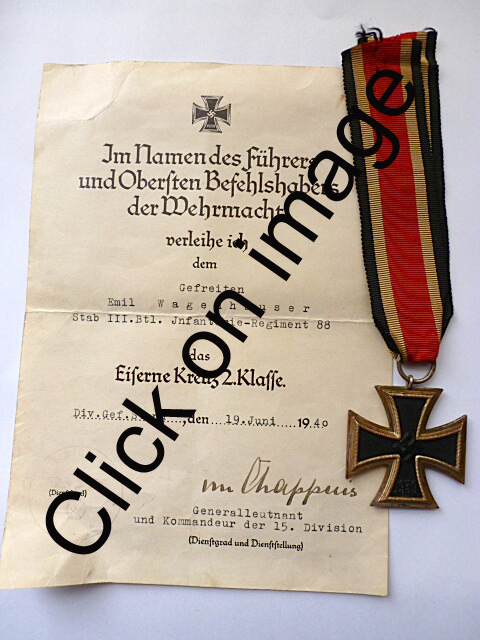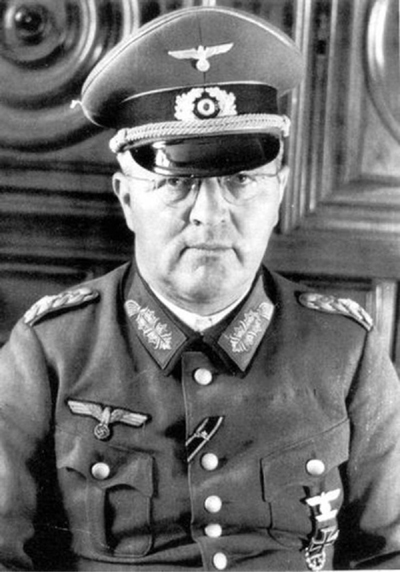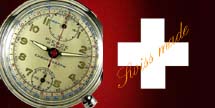 Emil Wagenhäuser was born on the 4th of June 1912 in Wurzburg. On the day he received the Iron Cross 2nd class (19th June 1940) he was a 28 year old gefreiter (the rank of Gefreiter was considered in English the equivalent to a British Army Lance Corporal) in Stab III battalion Infanterie-Regiment 88 which was part of the 15. Infanterie Division. He died on the battlefield just before his 30th birthday at the 13th of may 1942 in Sofiivka, Ukraine. At that time he was an Unteroffizier (a full Corporal rank subordinate Non-Commissioned Officer). His body lies still somewhere in Sofiivka, Ukraine some 50 miles southwest of Charkov Emil Wagenhäuser was born on the 4th of June 1912 in Wurzburg. On the day he received the Iron Cross 2nd class (19th June 1940) he was a 28 year old gefreiter (the rank of Gefreiter was considered in English the equivalent to a British Army Lance Corporal) in Stab III battalion Infanterie-Regiment 88 which was part of the 15. Infanterie Division. He died on the battlefield just before his 30th birthday at the 13th of may 1942 in Sofiivka, Ukraine. At that time he was an Unteroffizier (a full Corporal rank subordinate Non-Commissioned Officer). His body lies still somewhere in Sofiivka, Ukraine some 50 miles southwest of Charkov
At the start of the second world war, the Infanterie-Regiment 88 was a section of the 15th Infanterie Devision. On 19 November 1940 the III Battelion of the Infanterie Regiment 88 was transferred to Infanterie Regiment 260 which was a section of the 113th Infantry Division.
By late January 1942, the first part of the 113th Division arrived after a short detour via Odessa Nowomoskowsk in Dnepropetrovsk. The last remnants of the division arrived in April 1942. Until that time, the division had kept, after initial counterattacks, their positions in the frontline. End of April 1942, the division was relieved by the 4th Romanian Division to hold the lines and the 113th division assembled in the area north of Orel southeast of Krsanograd. Here it services first as Army Group reserve. After the start of the Russian spring offensive on 12 May 1942, the division was just recouperating in the area in the center of the russian attack. It was therefore used in the defense of Orel Krawanskoje. In heavy fighting the division was able to maintain a cohesive front line, even when they were pushed it north until mid may of 1942 when operation "Fridericus" was to cut the broken through Russian troops.
It is most likely that Emil Wagenhäuser was killed in action during this Russian offensive on the 13th of may 1942.
This particular Iron Cross is stamped “3” on the ring. This indicates that the manufacturer is Wilhelm Deumer from Ludenscheid.
The diploma of the iron cross is signed by Generalleutnant Von Chauppuis who was commander of the 15th Infantry Division from 6 October 1939 - 12 August 1940. His full name was Friedrich-Wilhelm von Chappuis . He committed suicide the 27th of August 1942.

Generalleutnant F.W. von Chappuis (13 September 1886 – 27 August 1942)
At the beginning of the Second World War, the Iron Cross 2nd Class was still highly regarded. In later war years however it was rewarded with much more ease. Still most recipients would wear the award with the same amount of proud ness. The Iron Cross 2nd Class was the first grade within the Iron Cross that was to be obtained for an individual act of bravery.
The official criteria were the individual and single act of bravery in the face of the enemy or actions that were above and beyond the normal call of duty. The approximately three million awarded crosses were obtained by German Military, Axis military and civilian uniformed organisations.
The cross measures 44 mm in diameter and hangs from a ribbon in the colours black white and red. The wide red band in the middle is being flanked by two equal white bands that both again are being flanked by a black band. During the whole war the production was retained with a high quality. On the front side one can find a Swastika and the year 1939, while the obverse contains the year 1813 on the lower arm.
Almost all World War Two crosses were made out of three parts, the Iron core and a silver rim on the front and backside. The two silver rims were welded together, holding the iron core. The core was produced from iron and was blackened. This core made the Iron Cross to be magnetized. Some examples are not magnetized because they were produced with brass or cupper. This version was especially welcome with members of the Kriegmarine. This core lasted longer in the exposure of salty sea water. The rim was supposed to be made from silver, but more common was the use of “German Silver”, a less expensive alloy of cupper, zinc and nickel. At the top a ring was welded to hold the loop for the ribbon. On the loop one can often find the manufacturers name although it is not uncommon that no name is placed. Therefore the absence of the manufacturers name is not a criterion to classify the cross as original or not.
The Iron Cross could be received in two different ways. The most exclusive way was in a leather box. More common was the bleu coloured envelop with in gothic letters the words “Eisernes Kreuz 2.Klasse”. The presentation was accompanied with a standard document. The receiving was also to be written down in the recipients “Soldbuch”or “Wehrpass”. The document normally didn’t contain the reason for obtaining the Cross, although in some occasions it was written down on the backside of the document.
It was not usual to wear the decoration it self. In stead a ribbon was worn on the left breast of hanging from the second button hole of the tunic in the way of the former Prussian Army.
In 1957 a special version of the cross was produced. On this the Swastika was replaced with an oak leaf. The way military actions of the Second World War could be honoured without the use of the forbidden Nazi-symbols. Most veterans however choose to wear the decoration as a ribbon only. Most 1957 versions are of a lesser quality than wartime examples. |



